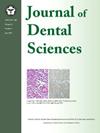口腔健康知识普及与 COVID-19 期间口腔健康自我评估变化之间的关系
IF 3.4
3区 医学
Q1 DENTISTRY, ORAL SURGERY & MEDICINE
引用次数: 0
摘要
背景/目的健康素养被认为在实施健康行为方面发挥重要作用,例如预防2019冠状病毒病(COVID-19)。在本研究中,我们旨在研究2019冠状病毒病大流行期间口腔健康素养(OHL)、饮食素养(DL)与口腔健康和饮食习惯变化之间的关系。材料与方法通过网络调查公司进行自我评估问卷,问卷内容包括COVID-19大流行各时期的口腔和饮食状况、信息来源、OHL、DL和COVID-19预防措施的频率。根据中位数得分,所有参与者被分为低识字率组和高识字率组:高识字率组高于中位数,低识字率组等于或低于中位数。对两组患者进行比较。结果纳入研究的344名参与者(男性168名,女性176名)的中位OHL和DL得分分别为16和17;160名(46.5%)参与者OHL得分高,157名(45.6%)参与者DL得分高。与低OHL或DL组相比,高OHL或DL组倾向于收集医疗专业人员发送的信息,口腔和饮食状况的自我评估得分显著较高,并且倾向于在进食情况下更频繁地实施感染控制行动。结论高OHL和高DL人群收集专业人员信息,无论是否患有COVID-19,均已达到口腔和饮食状况,并倾向于在口腔健康和饮食方面实施感染预防措施。本文章由计算机程序翻译,如有差异,请以英文原文为准。
Relationship between oral health literacy and changes in self-assessment of oral health during COVID-19
Background/purpose
Health literacy is thought to play a major role in implementing health behaviors, such as preventing coronavirus disease 2019 (COVID-19). In this study, we aimed to examine the relationship between oral health literacy (OHL), dietary literacy (DL), and changes in oral health and eating habits during the COVID-19 pandemic.
Materials and methods
The self-assessment questionnaire, including questions on oral and dietary conditions for each period of the COVID-19 pandemic, sources of information, OHL, DL, and frequency of COVID-19 prevention measures, was administered using a web research company. All participants were divided into low- and high-literacy groups based on the median scores: those who scored above the median in the high group and those who scored at or below the median in the low group. Comparisons were conducted between the two groups.
Results
The median OHL and DL scores were 16 and 17 for the 344 participants included in the study (168 males and 176 females); 160 (46.5%) participants had high OHL scores, and 157 (45.6%) had high DL scores. The group with high OHL or DL tended to collect information sent by medical professionals compared to the group with low OHL or DL, had significantly higher scores on self-assessment of oral and dietary conditions, and tended to implement infection control actions more frequently in eating situations.
Conclusion
The high OHL and DL groups gathered information from professionals to have attain oral and dietary conditions regardless of COVID-19 and tended to implement infection prevention measures in oral health and diet.
求助全文
通过发布文献求助,成功后即可免费获取论文全文。
去求助
来源期刊

Journal of Dental Sciences
医学-牙科与口腔外科
CiteScore
5.10
自引率
14.30%
发文量
348
审稿时长
6 days
期刊介绍:
he Journal of Dental Sciences (JDS), published quarterly, is the official and open access publication of the Association for Dental Sciences of the Republic of China (ADS-ROC). The precedent journal of the JDS is the Chinese Dental Journal (CDJ) which had already been covered by MEDLINE in 1988. As the CDJ continued to prove its importance in the region, the ADS-ROC decided to move to the international community by publishing an English journal. Hence, the birth of the JDS in 2006. The JDS is indexed in the SCI Expanded since 2008. It is also indexed in Scopus, and EMCare, ScienceDirect, SIIC Data Bases.
The topics covered by the JDS include all fields of basic and clinical dentistry. Some manuscripts focusing on the study of certain endemic diseases such as dental caries and periodontal diseases in particular regions of any country as well as oral pre-cancers, oral cancers, and oral submucous fibrosis related to betel nut chewing habit are also considered for publication. Besides, the JDS also publishes articles about the efficacy of a new treatment modality on oral verrucous hyperplasia or early oral squamous cell carcinoma.
 求助内容:
求助内容: 应助结果提醒方式:
应助结果提醒方式:


